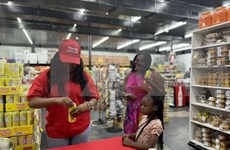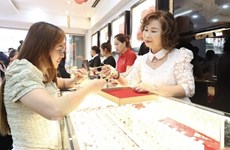‘Green' farming key to exports of tra fish
The environmental impacts of aquaculture and sustainable production
practices have become important factors in purchasing decisions made by
export markets, experts have said.
The environmental impacts of aquaculture and sustainable production
practices have become important factors in purchasing decisions made by
export markets, experts have said.
Farmers, breeders and processors should be aware of this and apply strict standards in all their operations, Pham Anh Tuan, deputy director of the General Department of Fisheries told a conference in HCM City on April 25.
The conference, which focused on tra (pangasius) exports, heard that Vietnam exported 153,062 tonnes of the fish worth 376,430 USD in the first three months of the year, an increase of 5.2 percent in volume and 21.6 percent in value over the same period last year.
While releasing these figures, To Thi Tuong Lan, Deputy General Secretary of the Vietnam Association of Seafood Exporters and Producers (VASEP), said that the increase in value reflected a rise in export price.
There has been a steady increase in the export price for tra fillets of late, according to Lan.
Tra fish shipped to Europe fetches about 3.2 USD – 3.3 USD per kilo, up 22 percent over the end of last year, while US shipments fetch higher prices of nearly 4 USD per kilo.
The prices are expected to increase by another 10 percent or so in the coming months because of supply shortages.
Currently, EU is the largest importer of Vietnamese tra fish, accounting for 33.1 percent of the country's total pangasius exports, followed by the US and Japan .
Pangasius export to South America, especially Brazil , Russia and several Asian countries has also surged strongly in the past three months.
However, Lan also cautioned against optimism, saying several challenges still lay ahead, including a shortage of raw materials and rising production costs.
Though exporters and processors were offering high prices of 28,500-28,800 VND per kilo, they were still finding it very hard to get enough tra fish, she said.
This scarcity was expected to last until the year-end, she added.
The total tra output is estimated at 500,000 tonnes this year, about 100,000 tonnes less than in 2010.
Many seafood processors in southern provinces are upset about the severe shortage in raw materials, as their facilities are running far below designed capacity.
Nguyen Huu Dung, Vasep Deputy Chairman, said high interest rates and the increase in production costs caused a lot of difficulties for processors and exporters.
Acknowledging the problems, Luong Le Phuong, Deputy Minister of Agriculture and Rural Development, advised enterprises to "review and cut unnecessary costs and seek measures to use electricity more efficiency to lower their production costs."
He also asked the Fisheries General Department to work with local seafood processors and exporters as well as local authorities to encourage a shift from quantity to quality so that fish breeding and farming could develop in a sustainable manner.
Pham Anh Tuan, deputy director of the Fisheries General Department, agreed with Phuong, saying the current difficulties were rooted in the quantity-based development that had taken place over the last 10 years.
"This challenge is also an opportunity for the sector to restructure," he said.
"Consumers nowadays not only require good quality products but also require that the production process does not have a negative impact on the environment," he said.
Tuan said his department was collecting ideas from businesses and relevant agencies for a new decree on pangasius production and consumption that could be submitted to the Government for approval by the end of May.
Based on global Gap (Good Agriculture Practices) norms, the department plans to set up national standards for pangasius and shrimp production, according to Tuan.
The department also expects to sign a Memorandum of Understanding with the GlobalGap organisation in May for training Vietnamese staff in application and certification of GAP standards.
Applying GAP in pangasius production would help ensure their quality and reduce environmental impacts as well as diseases that affect the crop frequently, he said./.
Farmers, breeders and processors should be aware of this and apply strict standards in all their operations, Pham Anh Tuan, deputy director of the General Department of Fisheries told a conference in HCM City on April 25.
The conference, which focused on tra (pangasius) exports, heard that Vietnam exported 153,062 tonnes of the fish worth 376,430 USD in the first three months of the year, an increase of 5.2 percent in volume and 21.6 percent in value over the same period last year.
While releasing these figures, To Thi Tuong Lan, Deputy General Secretary of the Vietnam Association of Seafood Exporters and Producers (VASEP), said that the increase in value reflected a rise in export price.
There has been a steady increase in the export price for tra fillets of late, according to Lan.
Tra fish shipped to Europe fetches about 3.2 USD – 3.3 USD per kilo, up 22 percent over the end of last year, while US shipments fetch higher prices of nearly 4 USD per kilo.
The prices are expected to increase by another 10 percent or so in the coming months because of supply shortages.
Currently, EU is the largest importer of Vietnamese tra fish, accounting for 33.1 percent of the country's total pangasius exports, followed by the US and Japan .
Pangasius export to South America, especially Brazil , Russia and several Asian countries has also surged strongly in the past three months.
However, Lan also cautioned against optimism, saying several challenges still lay ahead, including a shortage of raw materials and rising production costs.
Though exporters and processors were offering high prices of 28,500-28,800 VND per kilo, they were still finding it very hard to get enough tra fish, she said.
This scarcity was expected to last until the year-end, she added.
The total tra output is estimated at 500,000 tonnes this year, about 100,000 tonnes less than in 2010.
Many seafood processors in southern provinces are upset about the severe shortage in raw materials, as their facilities are running far below designed capacity.
Nguyen Huu Dung, Vasep Deputy Chairman, said high interest rates and the increase in production costs caused a lot of difficulties for processors and exporters.
Acknowledging the problems, Luong Le Phuong, Deputy Minister of Agriculture and Rural Development, advised enterprises to "review and cut unnecessary costs and seek measures to use electricity more efficiency to lower their production costs."
He also asked the Fisheries General Department to work with local seafood processors and exporters as well as local authorities to encourage a shift from quantity to quality so that fish breeding and farming could develop in a sustainable manner.
Pham Anh Tuan, deputy director of the Fisheries General Department, agreed with Phuong, saying the current difficulties were rooted in the quantity-based development that had taken place over the last 10 years.
"This challenge is also an opportunity for the sector to restructure," he said.
"Consumers nowadays not only require good quality products but also require that the production process does not have a negative impact on the environment," he said.
Tuan said his department was collecting ideas from businesses and relevant agencies for a new decree on pangasius production and consumption that could be submitted to the Government for approval by the end of May.
Based on global Gap (Good Agriculture Practices) norms, the department plans to set up national standards for pangasius and shrimp production, according to Tuan.
The department also expects to sign a Memorandum of Understanding with the GlobalGap organisation in May for training Vietnamese staff in application and certification of GAP standards.
Applying GAP in pangasius production would help ensure their quality and reduce environmental impacts as well as diseases that affect the crop frequently, he said./.












